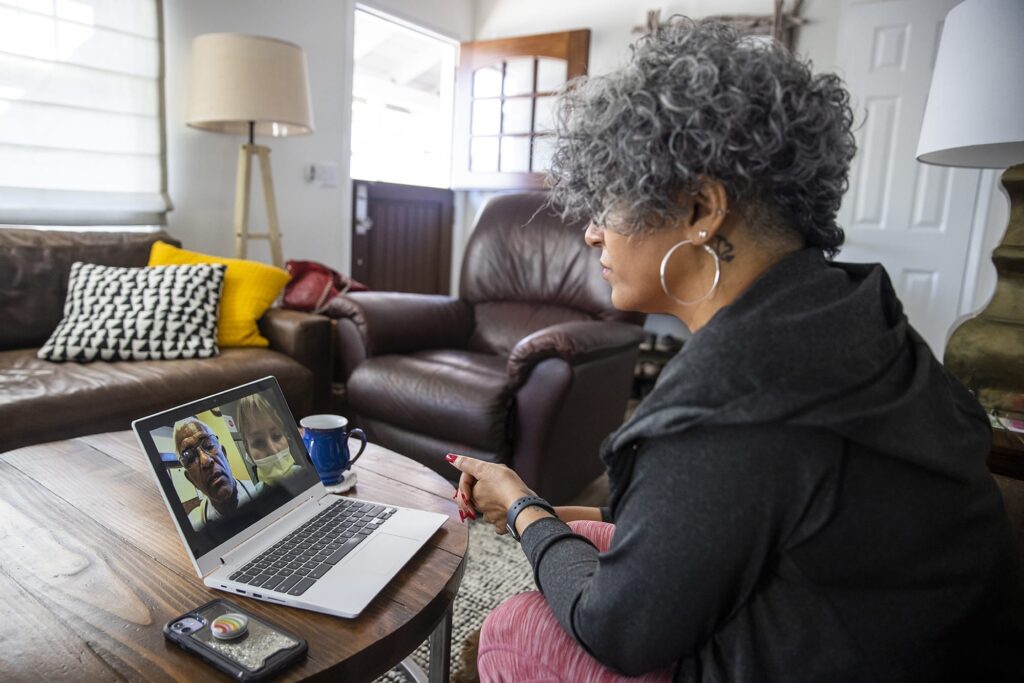
How does virtual health help us take a step forward in humanizing healthcare? It works within and around a person’s life, as opposed to their sickness, to deliver care when, where and how patients need and want it.
By Sharon Peifer, Ed.D, senior clinical consultant, Medecision
Note from the editor: This post was originally published in June 2020 and was last updated in February 2021.
The use of virtual health technologies, such as videoconferencing and online chat platforms, has skyrocketed over the past year. Prior to 2020, virtual health and telehealth platforms were not widely used. In fact, a November 2019 consumer study found that only 12% of U.S. adults had used a telehealth app. On the physician side, only 28% of doctors reported using telehealth technologies in 2019, according to the American Medical Association.
However, the COVID-19 pandemic changed the course of telehealth, as in-person doctor appointments were brought to a screeching halt. Experts suggest that telehealth usage will continue to rise.
In early June 2020, Seema Verma, administrator of the Centers for Medicare and Medicaid Services (CMS), said she “can’t imagine going back,” explaining that expanded access to virtual care should continue long after the coronavirus pandemic eventually recedes.
Why? The increased use of telehealth and virtual care delivery can help humanize the healthcare experience, making healthcare more accessible and convenient for patients. “As providers become more engaged, informed, and involved with their health care decisions, and demand better access to care, virtual health solutions will play an important role in meeting expectations,” according to a 2019 report from Deloitte. “Virtual health is continuing efforts to humanize health care by extending and expanding the concept of a patient-centric care delivery model into one that is truly life-centric.”
To be clear, virtual health technologies are not a replacement for in-person care. Instead, these technologies—video, email, chat or texting, or phone calls—allow healthcare to work in and around an individual’s life. People don’t just want care when they’re sick. They also want to be able to receive preventive care or ask their providers questions when needed. But hectic work or school schedules can make it difficult to take a couple of hours to go to the doctor. Virtual health technology allows for more flexibility—whether that’s after the children go to bed or while sitting in your office during your lunch break.
According to Deloitte, healthcare consumers want access to care when, where and how best it suits them. Plus, people want a personalized healthcare experience, and tools to help them manage their healthcare.
For example, at the Cleveland Clinic, patients who have bone marrow transplants are provided with a blood pressure cuff, thermometer and activity tracker, and nurses can remotely monitor patients’ health. This keeps patients—especially those who travel long distances for follow-up appointments—from making unnecessary visits that only take a few minutes.
Virtual health technologies also allow for better, more efficient collaboration. Care team members, specialists, social workers and even out-of-state providers can use virtual technology to collaborate and develop care plans that best serve the patient’s needs.
Humanizing the Care Management Experience
Healthcare providers are not the only ones to use virtual care technologies to communicate with and care for patients. Care managers are also taking advantage of the virtual care benefits to provide better service to health plan members.
Just like virtual health technology helps keep communication pathways open for providers and patients, the same is true for care managers and health plan members. Care managers address a variety of conditions and complicated situations with health plan members—such as disease management, behavioral health issues, and social determinants of health like homelessness, food insecurity and transportation issues. Virtual care technologies, like videoconferencing software and chat platforms, can help care managers establish solid relationships and build trust. Care managers can connect health plan members with resources, educational materials and tools to help them manage their care—that virtual connection can be reassuring and empowering to the individual, making them feel like they are supported in their healthcare journeys.
Take, for instance, Medecision’s AerialTM platform. Aerial allows healthcare consumers, care managers, and care teams to connect more easily. Plus, with Aerial InCircle, individuals can create a circle of care and invite others—such as physicians, family members or caregivers—into the circle to communicate about their health. This highly personalized experience gives people more confidence in managing their health and comfort knowing that they can easily speak with their care team.
Want to learn more about how Medecision’s Aerial platform can help humanize the healthcare experience for healthcare consumers? Click here.



About The Author: Sharon Peifer, Ed.D
Sharon Peifer, Ed.D, is a Senior Clinical Consultant at Medecision, partnering with healthcare clients to consult and train on the Aerial platform. She is also an Adjunct Professor at both Liberty University and Jefferson College of Population Health, teaching healthcare informatics. She is skilled in healthcare, managed care, team building, and leadership.
More posts by Sharon Peifer, Ed.D